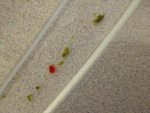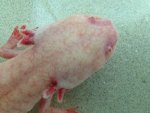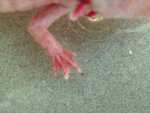misshippo27
New member
- Joined
- Oct 2, 2011
- Messages
- 10
- Reaction score
- 0
- Points
- 1
- Country
- United States
I have a very sick looking axolotl. He's a GFP Albino. Just over a month ago noticed his gills looked smaller. I thought it was from the other axolotl at first, but then I noticed a strange offshoot from one of his front digits. It looked like shedding skin but now I'm thinking it looks more like a odd digit regrowth. The same front limb began appearing vascularized- quite red, which was spreading up. I assumed he had a fungus (the lobe looked like it could be) and by reading other posts, his symptoms seemed to fit. Up until now I hadn't seen any other evidence of fungi as he is white-colored and so it's difficult to discern. At this point I began refrigerating him (5ºC) and giving him salt baths every other day. They are for 15 minutes using API aquarium salt. I use just under 1/8 of a cup in half a gallon of water.
I wasn't home over the weekend and so he went an extra day without the salt bath. Up until then he was starting to look good, his gills were slowly regrowing and the vascularization disappeared. The black digit tips on his toes had grown back too. The weird lobe has remained constant however. When I looked at him today, his gills had gotten much worse than before. There also appears to be a white substance along his gill sides, but I'm unsure whether this is fungus or morphologically natural as I've never seen his gills so short.There were pink gill parts floating in the water along with a green substance which I can only guess was excrement. I've been leaving a couple of salamander pellets in with him (his and his tank mate diet) but he hasn't been eating since being in the fridge. I didn't think this was an issue as I knew his metabolism would slow due to the cold. I'm thinking that I should do the salt bath every day? If anyone has any more suggestions I'm all ears! His tank mate has long fluffy gills and no sign of distress (water levels are as they should be).
I wasn't home over the weekend and so he went an extra day without the salt bath. Up until then he was starting to look good, his gills were slowly regrowing and the vascularization disappeared. The black digit tips on his toes had grown back too. The weird lobe has remained constant however. When I looked at him today, his gills had gotten much worse than before. There also appears to be a white substance along his gill sides, but I'm unsure whether this is fungus or morphologically natural as I've never seen his gills so short.There were pink gill parts floating in the water along with a green substance which I can only guess was excrement. I've been leaving a couple of salamander pellets in with him (his and his tank mate diet) but he hasn't been eating since being in the fridge. I didn't think this was an issue as I knew his metabolism would slow due to the cold. I'm thinking that I should do the salt bath every day? If anyone has any more suggestions I'm all ears! His tank mate has long fluffy gills and no sign of distress (water levels are as they should be).





